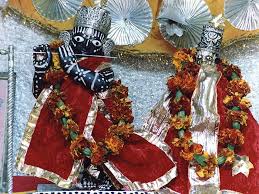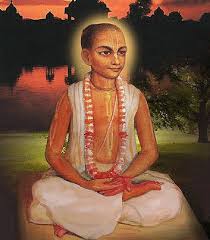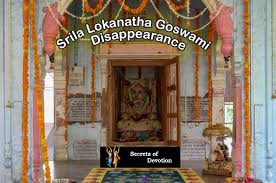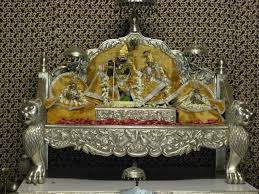Quote by Indradyumna Swami
During the moment of sudden difficulty, how can we think positively at that time?
→ The Spiritual Scientist
Answer Podcast
The post During the moment of sudden difficulty, how can we think positively at that time? appeared first on The Spiritual Scientist.
Friday, July 10, 2020
→ The Walking Monk
Toronto, Ontario
Getting Ready
My tooth—the left crown—popped out during my meal yesterday. I was lucky to book an appointment today for a temporary fix-it job at the dentist. I sat on the chair, which was elevated upward, with my head bent back, which exposed me to their TV screen in the ceiling. There I saw Anita Sharma—the anchor for Bloomberg News. “That’s my former Sunday school student,” I said to the surprise of the dental hygienist.
I felt a sense of pride. Anita does a mighty fine job with her broadcast voice.
Anyway, it was time to set my crown back into its location, however, when I got back to the ashram, on my first bite, before I had a chance to swallow, it popped out again like a weasel. A bridge job is now to follow. No problem! An appointment is in place.
In the meantime everyone is getting ready for the festival of Jagannath, the Universal Lord. It’s going to be a virtual display this year, due to the Covid-19 pandemic. There’s excitement in the air. I did receive an email for booking a zoom class for the community in Ujjain, which was the headquarters for the late Bhakti Caru Swami. This is an honour. We are looking at a community that is naturally in a state of grieving.
No walking again for me today. The humidity is too much outside, so mopping the temple floor was my option in preparation for tomorrow. That was just awesome for me.
May the Source (Jagannath) be with you!
0 km
https://www.instagram.com/p/CCgVSelAadE/
The Monk’s Podcast 33 with Anuttama Prabhu – Going beyond the we-they mentality
→ The Spiritual Scientist
Podcast
Video:
The post The Monk’s Podcast 33 with Anuttama Prabhu – Going beyond the we-they mentality appeared first on The Spiritual Scientist.
Searching for Solace
→ ISKCON News
In Ujjain: “You choose to paint as the cover of the book a picture of your heart,” I almost asked him to confess. No words replied he only sighed a soft and thoughtful “yes.” * * * * A little boy in short pants is walked home by his father. Side by side, closely […]
The post Searching for Solace appeared first on ISKCON News.
Searching for Solace
→ ISKCON News: Latest Stories
Lokanatha Goswami Disappearance
→ Ramai Swami
lokanathakhya-gosvamishri-lila-manjari pura
Lokanatha Goswami was known as Lila Manjari in Krishna lila. (Gaura-ganoddesha-dipika 187)
Lokanatha is considered to be Mahaprabhu’s direct disciple and associate. Prior to coming to Navadwip, he lived in the village of Talakharii in Jessore district in what is now Bangla Desh. Prior to that, he lived in Kachna Paria. His father’s name was Padmanabha Chakravarti and his mother Sita Devi.
Lokanatha Goswami renounced the householder ashrama in 1431 of the Shaka era (1510) and came to meet Mahaprabhu in Navadwip. Mahaprabhu immediately told him to go and live in Vrindavan, telling him that it was His own intention to take sannyas very shortly and go there Himself.
Lokanatha started to cry when he imagined the Lord with His beautiful curls shorn and the distress the Devotees would feel at His departure. When the Lord saw Lokanatha’s anxiety, He embraced him and consoled him with various spiritual instructions and Lokanatha surrendered completely to Him. When Bhugarbha saw how unhappy Lokanatha was, he decided to accompany him to Vrindavan.
When he got the news that Mahaprabhu had taken sannyas and then gone to Puri and thence to the South on pilgrimage, Lokanatha hurried to Southern India in order to join Him. When he arrived in the South, he heard that Mahaprabhu was no longer there, but had gone to Vrindavan. Lokanatha immediately set off for Vrindavan, hoping to see the Lord there, but by the time he arrived, he heard that the Lord was now in Prayag.
Lokanatha was disappointed, but still determined to see the Lord and decided to set off again for Prayag. This time, however, Mahaprabhu appeared to him in a dream and told him to stop running around and remain in Vrindavan and do his bhajana. Not long afterwards, Rupa, Sanatan, Gopal Bhatta Goswamis and others of the Lord’s associates started coming to live in Braj. Their association cheered him immensely.
Lokanatha Goswami worshiped Radha and Krishna in a state of separation, increasing the intensity of his renunciation. He was afraid of the slightest amount of fame. Thus he forbad Krishnadas Kaviraj Goswami to write anything about him in the Chaitanya Charitamrita, with the result that only his name can be found mentioned there.
Lokanatha Goswami constantly travelled through Braj, ecstatically visiting the various holy places where Krishna had engaged in His pastimes. Once, he came to Khadiravana. Then he visited Kishori Kund near the village of Umarao by Chatravana. He was so impressed by the beauty of the site that he stayed there for some time to do his bhajana in isolation. After being engaged in this way for some time, he developed a deep desire to worship Radha and Krishna in the Deity form.
The Lord knows the desires of His Devotees and feels Himself obliged to fulfill them. He came personally to give Lokanatha a Deity, telling him that Its name was Radha Vinoda before disappearing. Lokanatha was astonished to see the Deity and then filled with anxiety at the thought that the Lord Himself had come and gone.
But Radha Vinoda cast His sweet glance on Lokanatha and said to him, “I live here on the banks of Kishori Kund in the village of Umarao. I saw your eagerness to serve Me and so I came here Myself. Who else would have brought Me to you? I am very hungry. Quickly prepare something for Me to eat.”
When he heard these words, tears began to flow from Lokanatha’s eyes. He quickly started cooking for Radha Vinoda and then made an offering which the Deity ate with great satisfaction. He then made Him a bed of flowers upon which he placed Him, fanned Him with branches and joyfully massaged His feet.
Lokanatha devoted himself in body, mind and soul to Radha Vinoda. He wondered where he would keep the Deity, and decided to make a large bag which became Radha Vinoda’s Temple. He kept his worshipable Lord constantly close to his heart like a necklace.
This attracted the people of Braj to Lokanatha and they wanted to built a house for him and his Deity, but he refused. He was so renounced that he accepted nothing other than what he absolutely needed for the Deity’s service. Narottama Das became Lokanatha’s disciple.
Lokanatha Goswami left this world somewhere around 1510 Shaka (1588-9 AD) in the month of Asharh, on the eighth day of the dark moon. His samadhi tomb is found in the Radha Gokulananda Temple in Vrindavan. His Radha Vinoda Deity is also being served in the same Temple.
How to Keep Devotees Together and Bring Them Closer to Krishna
Giriraj Swami
How to keep the devotees together and closer to Krishna?
How to keep the devotees together and closer to Krishna?
ISKCON Scarborough – Dr Keshav Anand das – Going Beyond Prayers!
→ ISKCON Scarborough
HH Bhakti Charu Swami’s Samadhi Ceremony
→ Dandavats
 By Ananda Tirtha das
By Ananda Tirtha das HH Bhakti Charu Swami's vapu will be placed in samadhi on Monday, July 13th morning, India time. As Maharaj’s Vapu enters into Samadhi on Monday 13th July early morning (IST), you may wish to engage in deep prayer in honor of Maharaj. There are many prayers of the Vaishnava Acharyas that we can recite. Continue reading "HH Bhakti Charu Swami’s Samadhi Ceremony
→ Dandavats"
H.H. Bhakti Charu Swami Samadhi Program
→ Mayapur.com
Monday 13th July 2020 (from 4.30am IST) Sridham Mayapur The Samadhi Puja of His Holiness Bhakti Charu Swami commences at: US PDT: 4:00pm (Sunday 12th July) US EDT: 7:00pm (Sunday 12th July) UK: 12:00am (Monday 13th July) South Africa: 1:00am (Monday 13th July) India: 4.30am (Monday 13th July) Bangladesh: 5:00am (Monday 13th July) Singapore: 7:00am […]
The post H.H. Bhakti Charu Swami Samadhi Program appeared first on Mayapur.com.
Take Part in Samadhi Ceremony
→ Mayapur.com
Submit your Offering to HH Bhakti Charu Swami. HH Bhakti Charu Swami’s Samadhi Ceremony will be held tomorrow. If you wish to offer sand or salt on your behalf, please send your names to the WHATSAPP number: +918436621172 ( only as WhatsApp message )
The post Take Part in Samadhi Ceremony appeared first on Mayapur.com.
How to bring the members of ISKCON together with each other and nearer to Krishna (video)
→ Dandavats
 By the ISKCON GBC Strategic Planning Team
By the ISKCON GBC Strategic Planning Team Please join us to hear from Radhanath Swami on the Purpose #3 of ISKCON (To bring the members of the Society together with each other and nearer to Krishna, the prime entity, thus developing the idea within the members, and humanity at large, that each soul is part and parcel of the quality of Godhead, Krishna) Continue reading "How to bring the members of ISKCON together with each other and nearer to Krishna (video)
→ Dandavats"
How Can I Be Connected To My Guru, In Multi Guru Society? (4 min. video)
→ Dandavats

How Can I Be Connected To My Guru, In Multi Guru Society? - Learning From HH Bhakti Charu Swami
Read More...ISKCON Ujjain: Grappling with the grief of losing our beloved spiritual father
→ Dandavats

At the present moment we find ourselves grappling with the grief of losing our beloved spiritual father. Indeed, a crater of agony has been carved deep into the core of our hearts. At this painful juncture of our journey towards Krishna, we can certainly feel the words of our Guru Maharaj come to life as we personally experience the wonderful support from Srila Prabhupada’s illustrious ISKCON family. The way all the senior leaders of our movement are remembering and glorifying Guru Maharaj, shows a glimpse of how much love Guru Maharaj shared with each and every devotee of ISKCON.
Read More...Five Lessons on Independence (video)
→ Dandavats

HG Gauranga Das Five Lessons on Independence ISKCON Towaco NJ July 11 2020
Read More...Day 2 – BBT Africa 11th Annual Conference (video)
→ Dandavats
 Day 2 - BBT Africa 11th Annual Conference - Bhakti Dhira Damodara SwamiRead More...
Day 2 - BBT Africa 11th Annual Conference - Bhakti Dhira Damodara SwamiRead More...Vaishnava Samadhi Park Proposal – Mayapur
→ Dandavats

A design proposal was made regarding this park a couple of years ago which was approved by all levels of Mayapur Management.
Read More...TOVP Tweets Now Tweeting!
- TOVP.org
The TOVP Communications Department is now tweeting on Twitter. This is yet another way to stay informed and in touch with news about our progress.
Just search for TOVP Tweets to Follow on Twitter or use the link: https://twitter.com/TOVP2022.
TOVP NEWS AND UPDATES – STAY IN TOUCH
Visit us at: www.tovp.org
Follow us at: www.facebook.com/tovp.mayapur
Find us on: https://twitter.com/TOVP2022
Watch us at: www.youtube.com/user/tovpinfo
View us 360° at: www.tovp360.org
App at: https://m.tovp.org/app
News & Texts at: https://m.tovp.org/newstexts
RSS News Feed at: https://tovp.org/rss2/
Buy from us at: https://tovp.org/tovp-gift-store/
Support us at: https://tovp.org/donate/seva-opportunities/
Why do some people find meaning in things and others don’t?
→ The Spiritual Scientist
Answer Podcast
The post Why do some people find meaning in things and others don’t? appeared first on The Spiritual Scientist.
Kirtan in Melbourne (6 min. video)
→ Dandavats

HH Bhakti Caru Swami sings Kirtan (6 min. video)
HH Bhakti Charu Swami coming home today!
→ Mayapur.com
Preparations are going on at Mayapur for Samadhi ceremony of HH Bhakti Charu Swami. Today at 12 noon, Maharaja’s vapu is expected to arrive at Delhi airport and by evening, will reach Kolkata. HH Bhakti Charu Swami ki Jai!
The post HH Bhakti Charu Swami coming home today! appeared first on Mayapur.com.
Srila Lokanath Gosvami – Disappearance
→ Dandavats
 By Krishna Das Kaviraj Goswami
By Krishna Das Kaviraj Goswami Srila Prabhupada gives the following information about Shri Lokanatha Goswami: "Shri Lokanatha Goswami was a personal associate of Shri Chaitanya Mahaprabhu and a great devotee of the Lord. He was a resident of a village named Talakhadi in the district of Yashodhara in Bengal. Previously he lived in Kachnapara. His father's name was Padmanabha, and his only younger brother was Pragalbha. Following the orders of Shri Chaitanya Mahaprabhu, shri Lokanatha went to Vrindavana to live. He established a temple named Gokulananda. Continue reading "Srila Lokanath Gosvami – Disappearance
→ Dandavats"
All glories to His Holiness Bhakti Charu Swami Maharaja!
→ Dandavats
 By Gopal Krishna Goswami
By Gopal Krishna GoswamiAs we all know, death is inevitable. Maharaja's disciples will undoubtedly be aggrieved beyond words. We must remember Srila Prabhupada's instructions on Guru-tattva at this moment. Prabhupada had explained several times that the guru is present in two forms - Vapu and Vani. Prabhupada had also explained that Vani is more important than Vapu. With regards to his own spiritual master, Prabhupada remarks in his dedication in the first canto of Srimad Bhagavatam - "He lives forever by his divine instructions and the follower lives with him". Continue reading "All glories to His Holiness Bhakti Charu Swami Maharaja!
→ Dandavats"
How to teach others and develop love for chanting the Holy names (video)
→ Dandavats
 By the ISKCON GBC Strategic Planning Team
By the ISKCON GBC Strategic Planning Team Let us join together to hear from the very experienced Kirtan leaders from London as they reaffirm the Purpose #4 of ISKCON (To teach and encourage the sankirtana movement, congregational chanting of the holy name of God, as revealed in the teachings of Lord Sri Caitanya Mahaprabhu) Continue reading "How to teach others and develop love for chanting the Holy names (video)
→ Dandavats"
Grieving for His Holiness Bhakti Charu Swami Maharaja
→ Dandavats
 By Hari-dhama dasa
By Hari-dhama dasaFrom our Lord Krsna’s perspective the departure of His Holiness Bhakti Charu Swami Maharaja was timely and planned. From our perspective it was untimely, unexpected and contrary to what we fervently prayed for. It was not what we wanted nor want we expected. For us, and in particular, for you as his disciples and followers, it can be considered as a “sudden death”: there was no poor prognosis, there was no terminal illness, and there was no extended period to prepare. And for those of you who prayed across the globe for Maharaja’s recovery may have found yourself perplexed that your prayers were not answered. These factors can compound your grief. Continue reading "Grieving for His Holiness Bhakti Charu Swami Maharaja
→ Dandavats"
Thursday, July 9, 2020
→ The Walking Monk
Healthy Voyage
A newly-made friend, Victor, and a friend of his, showed up at the temple ashram to join me on my night walk. As usual, we took time to admire nature’s features along the way. To begin with I pointed out Saskatoon bushes and, for certain, samples of its berries were tested. It met with their approval.
I pointed out the blue spruce, and by the time we completed the two hour trek, Victor had it down—in terms of recognizing this glorious tree. We noticed dozens of wildflowers, and in the pond, at the Brickworks, we spotted this massive dark carp. Baby bunnies were also in abundance, which may account for the presence of foxes and coyotes.
I did absolutely no chanting on this lovely walk. Philosophical discussion was more at Victor’s insistence.
All right then! We are observers of nature, of this body. We are the force and yet not the force. A greater intelligence watches over us and also over nature. “I am the taste of water. I am the light of the sun and the moon… I am time… Earth, water, fire, air, ether and mind, intelligence and ego are separated energies of a superior intelligence.”
Exploring the Gita’s wisdom through nature and our limited lifeexperience is a healthy voyage that should be walked-out on a daily basis.
May the Source be with you!
7 km
Searching for Solace
→ Dandavats
 By Bhurijana Das
By Bhurijana Das In Ujjain: “You choose to paint as the cover of the book a picture of your heart,” I almost asked him to confess. No words replied he only sighed a soft and thoughtful “yes.” Continue reading "Searching for Solace
→ Dandavats"
Vaishnava Samadhi Park Proposal
→ Mayapur.com
Project Outline There has always been a Vaisnava SamadhiPark planned for in the Mayapur Master A design proposal was made regarding this park acouple of years ago which was approved by all levels of Mayapur Management. This proposal needed to be revised in light of the Master Plan entry road being widened since it is […]
The post Vaishnava Samadhi Park Proposal appeared first on Mayapur.com.
Food For Life Wales Receives Award From UK Prime Minister
→ ISKCON News
ISKCON Cardiff temple president and Food For Life Wales Director Tarakanatha Das has received a Points of Light award from the UK Prime Minister’s office, and has accepted it on behalf of the prasadam distribution organization. The Points of Light award is presented to outstanding volunteers who are making a change in their community. On […]
The post Food For Life Wales Receives Award From UK Prime Minister appeared first on ISKCON News.
Food For Life Wales Receives Award From UK Prime Minister
→ ISKCON News: Latest Stories
Books are the Basis, The 11th Annual BBT Africa Conference
Giriraj Swami
A Calling, Divine
Bhakti Charu Swami
The Monk Epidemic — Resolved! (2 min. video)
→ Dandavats

The Monk Epidemic — Resolved! (2 min. video)
The most famous of all hypothetical inquiries — “if everyone becomes a sadhu, what will happen to the human population?!” His Holiness Bhakti Charu Swami Maharaja expertly explains how one can increase Krishna’s family manifold without even getting married. In the purest and most spiritual sense. A family so strong the members don’t seperate even after death and attain eternal lives which are full of knowledge and sheer, unending bliss.
H.H. Bhakti Charu Maharaja’s Last Visit to the TOVP (Album of photos)
→ Dandavats

His Holiness Bhakti Charu Maharaja was one of the most ardent and steadfast supporters of the TOVP. Over the years he personally spoke incessantly about the project, raised funds for construction, attended fundraising events, and was recently planning to travel with the North American TOVP Tour to many temples until the COVID-19 shut everything down. His temple in Ujjain is also overseeing the production of all the parampara murtis for the TOVP altar.
Read More...One Day We Will Meet Krishna (4 min. video)
→ Dandavats

One Day We Will Meet Krishna. Learning From HH Bhakti Charu Swami.
Read More...The purpose #1 of ISKCON: How to propagate spiritual knowledge throughout the whole world?
→ Dandavats
 By the ISKCON GBC Strategic Planning Team
By the ISKCON GBC Strategic Planning Team Let us hear from HH Bhakti Vijnana Goswami as he reaffirms the purpose#1 of ISKCON (To systematically propagate spiritual knowledge to society at large and to educate all people in the techniques of spiritual life in order to check the imbalance of values in life and to achieve real unity and peace in the world)
Continue reading "The purpose #1 of ISKCON: How to propagate spiritual knowledge throughout the whole world?
→ Dandavats"
FAITH AND SCIENCE
→ Dandavats

I’d first like to present to you the possibility that in your studies you’re going through something called the yoga of objectivity. This is a term coined by a philosopher at the University of Michigan, Henryk Skolimowski. What is this yoga of objectivity? If you’re going to understand something, you have to just separate yourself out from it. You undergo rigorous academic training, beginning as a young child, how to analyze the world in a quantifiable way. Doesn’t matter what your consciousness is – because after all who knows really what consciousness is? – Just study the facts, study the world as if it exists separate from you. That is what we call the yoga of objectivity.
Read More...
The 11th Annual BBT Africa Conference (video)
→ Dandavats
 By BBT Africa
By BBT Africa Connecting to Srila Prabhupada through his books. Join us for an insightful session on taking personal association of Srila Prabhupada through his books. Continue reading "The 11th Annual BBT Africa Conference (video)
→ Dandavats"
Triple lockdown ISKCON TRIVANDRUM
→ Dandavats

Trivandrum district is again under strict triple lockdown due to widespread of COVID. Police department called our temple and enquired whether we can continue our food distribution. We were not prepared due to shortage of funds. So they requested us to supply for one day atleast. We have started our service again. We wish and pray that we could continue our services. - Temple management
Read More...








